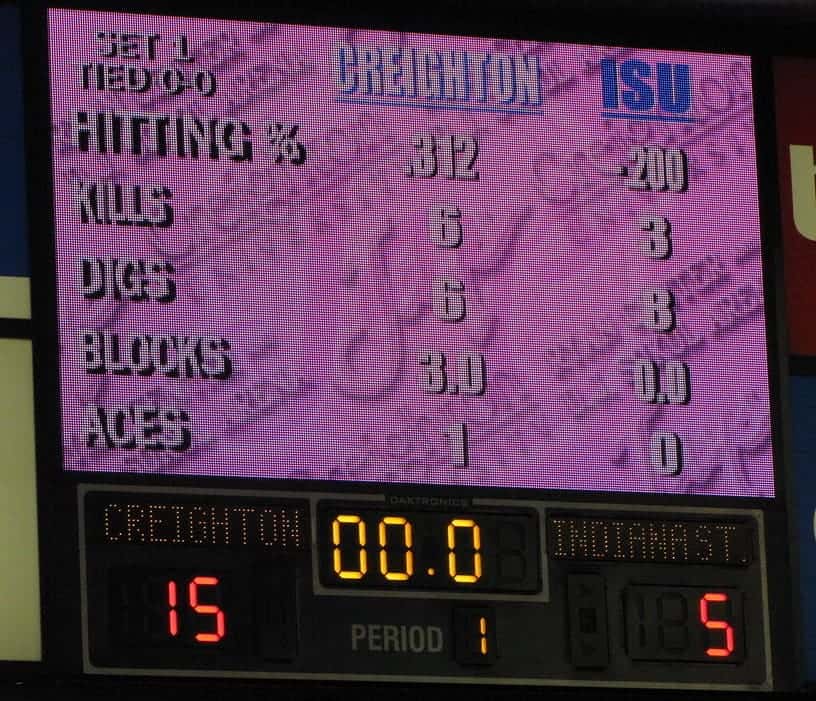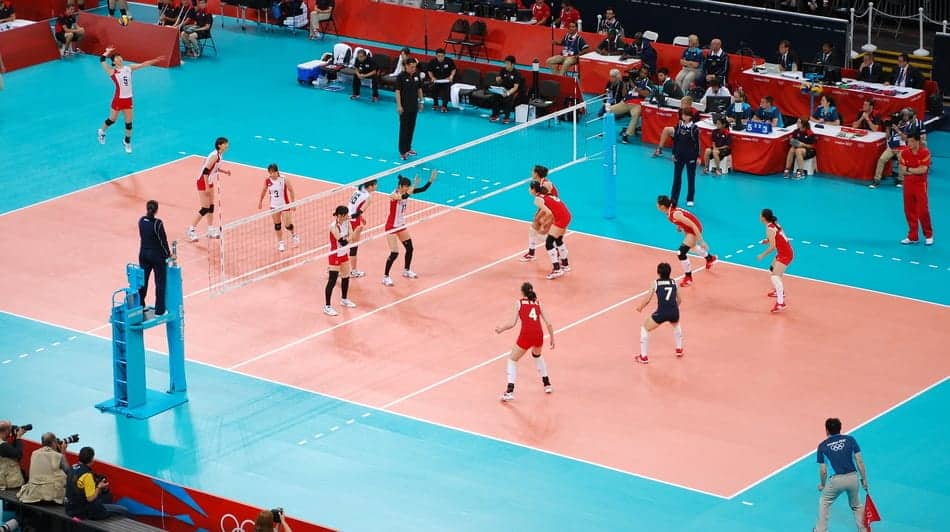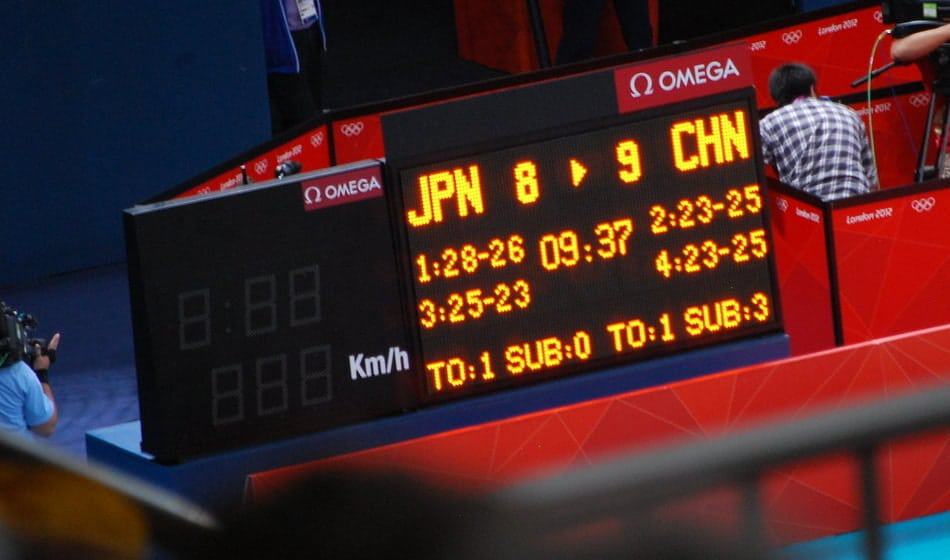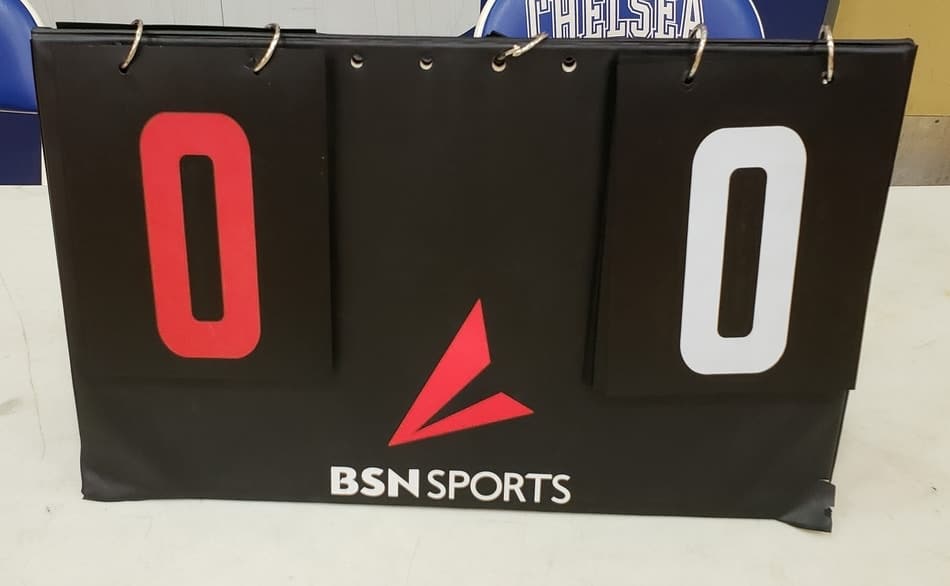A common question that comes up all the time as new people enter the volleyball community is the question of volleyball scoring. People are constantly asking how the scoring in volleyball works, and what on earth does rally scoring mean?
All volleyball in modern times is played with rally scoring. The rally scoring system is a system that assigns a point to whichever team wins every rally.
A rally is a play, so the winner of every single play wins a point. Even if the play never really gets going, a team may be awarded a point.
This means even when a team misses their serve, the other team gains a point. In fact, even if there is a fault before the serve (like an error in the rotation), whichever team did not make the mistake wins a point.
Why Is Rally Scoring So Puzzling For Some People?
1. After watching many different sports, it’s counter-intuitive.
Your team can literally do nothing successful and win a point? Yes, they can!
Imagine watching a football game and your team doesn’t even get possession of the ball, not even for a part of a play, but the other team gets enough penalties or mistakes and you get credit for a touchdown!?
Or what if you watched baseball and your team never left the dugout, yet somehow scored some runs?
That’s the first reason, it just feels unnatural. It seems like it shouldn’t be this way until you get used to it.
The thing to remember is that it’s fair because it works this way consistently for both teams. The rules are known and consistent, so if you play within the rules your team has an equal opportunity to score points.
2. The old scoring system used to be different.
It used to be called side-out scoring. Basically, your team had to serve the ball AND win the rally to gain a point. Many of us grew up playing under these rules (myself included), and never would have thought anything about it.
Many other sports use scoring that requires possession of the ball or a turn playing the offense. Remember that offense and defense switches constantly in volleyball, your team can be on both offense and defense many, many times during a single rally.
Would you like to learn more about the early years of volleyball? Check out our post on Who Invented The Game Of Volleyball.

Why Did Volleyball Change To Rally Scoring?
There are a few benefits to rally scoring and they far outweigh the drawbacks. Around the year 2000, depending on what level of volleyball you’re considering, leagues switched over to rally scoring.
Benefits To Rally Scoring
1. When every single rally earns a point, the game has a much faster pace and that translates into keeping the game exciting and entertaining. If you follow the volleyball community today, it’s a very up-tempo, exciting, fast-paced sport.
This culture begins with the scoring system and then is supported by short and limited time-outs and short intervals between sets and matches.
Take a moment to think about this: How many team sports could you watch an entire match in less than an hour and a half, possibly 2 hours at the most, consistently? And then think about that that time of the match may be divided up into 5 sets!
This is a massive change from the old days of volleyball when teams may trade serves back and forth over and over and the score on the board didn’t change.

2. The fact that every play earns a point limits the total number of plays possible in each set. Under the old system, you could trade the serve back and forth over and over without the number on the scoreboard changing once and this would make games just drag on and on!
In today’s volleyball, if every serve was an error, it would simply be a very short game.
Theoretically, you still have a game that can go on and on, but that’s just because of the “win by 2” rule. The teams would have to trade points, one or two at a time, over and over and no one ever gets ahead by 2. While this is possible, it’s very rare teams get over 27 or 28 points in the real world.
3. Because of the #2 benefit (limited number of rallies in a game), games can be projected to take a certain amount of time much more consistently. This helps SO much in scheduling, especially in tournaments.
Picture going to a tournament where your team is playing in a field of over 100 teams and they are divided up into pools of 4 teams each. Your team will play 3 opponents today to a best of 3 sets.
When tournament organizers can count on being able to play 1 game/hour it makes organizing such a huge tournament possible. It’s still a challenge for everyone to stay on pace, but at least it’s possible.
Drawbacks To Rally Scoring
1. It doesn’t seem fair sometimes to end up winning a point based on someone else’s failure, especially at the end of the game. It’s a strange thing to watch an opponent have a serving error and jump for joy and cheer that your team just won.
The truth is, this happens in other sports all the time as well, it just feels different in volleyball, especially at younger age groups. It feels wrong when the crowd is cheering that your child hit their serve into the net and instantly loses the game.
2. Every fault, even those that have to do with game procedure, gives up a point. In sideout scoring, a lot of times you would simply end up giving the serve back, but in rally scoring, it always costs you a point on the scoreboard.
This is also similar in other sports though. Consider how in football, if your team lines up wrong, or has too many players on the field when they break the huddle, you lose yardage (and your opponents gain it). The difference is that in volleyball, points are added to the scoreboard.
Scoreboards In Volleyball

In volleyball games, you’re usually going to have the officials using an electronic scoreboard. Usually there will be a large scoreboard above the game and then a scoreboard on the scorer’s table that the players, coaches, and referees can see without having to turn and look.
In tournaments, there are usually way too many games going on in any room to use the big electronic scoreboard on the wall. So in many tournaments the scoreboard on the scorer’s table will be the only one.

Using a flip scoreboard is common no matter what the venue or situation. In some cases, the scorer’s table will have an electronic version.
Benefits to flip scoreboards:
- 1. Low cost.
- 2. Super mobile, no setup required.
- 3. Easy for the scorer to hold up and show to the crowd around the room or arena occasionally to help everyone keep track of the score.
Scoreboard Apps
Nearly everyone uses smartphones these days and you can choose to keep track of the score on your phone for free. There are several free apps that are fantastic for this purpose.
The one I find the most helpful is called Score Keeper, but many others are just as good.
Many of these apps are very light (very little coding, very few details, and little explanation of how to actually use the app). A few helpful options that many have available are:

1. Being able to choose the team color on each side of the scoreboard. Instead of just leaving them as the default colors, change them to match the teams in play and this makes it super simple to remember which team has which score.
While this may seem very easy, you may be sitting at the end of the court where both teams are in front of you, not side-by-side.
2. Many apps will let you name the teams on each side. Whether you use the name of the school, the club or the mascot, this is most helpful during tournaments when all the opponents start to blur together after a few games.
3. At the end of the set, many apps will let you click something that switches the sides of the scoreboard (the colors and any name that you’ve put in will swap sides). This may seem trivial until you’re manually changing the colors back in the 5th set, then you’ll be wanting this option!
4. Some apps have multiple ways to tally the score. While you may be fine with just using the traditional tap on whichever team’s score to add a point, there are several variations you might try out.
One is using a swipe in either direction instead of a tap. Another is a tilting option, you tilt toward whichever team made the point.
5. A super cool option that’s available on some apps is when you can save the data from the games in the settings. It is very neat to be able to look back and scroll through the data from your games throughout the season or a tournament and see the scores (this is another reason you may take the time to name the teams each game).
Why Do Some Volleyball Games Start With A Score Of 4 – 4?
If you haven’t seen this before, it can be a very puzzling thing to watch for the first time. At many tournaments, this scoring system is used to speed up pool play in the beginning phase of the tournament.
Tournament organizers can guarantee that if they start the teams at a score of 4 – 4, and limit the play to just 2 sets per match, the teams will end each match in well under one hour. For scheduling purposes, this is very beneficial.
The drawback is that your team doesn’t have as much time to get into the game, it just ends so much quicker. If you know some of the players on the team are new to this, let them know ahead of time that they have no time to waste. These games go extremely fast and if your team gets on a bad streak, it’s over before you know it.
Related Questions
What Starts A Rally In Volleyball?
A rally always starts with a serve. The rally is the entire time between the serve and the end of the point when the referee blows the whistle.
The rally is the back and forth play competing for the point.
What Is The Scoring In Pickleball?
The scoring system in pickleball goes to 11 points, win by 2. Points can only be scored when you serve. The receiving team can’t score points.
For a complete guide to scoring in pickleball, check out this article that breaks it down from Pickleball Kitchen.
What Is The Score Sheet In Volleyball?
This is the document that’s used to tally the score and other game information during the game itself. When the game is over, it must be signed by the scorers, the referees, and the team captains to be verified.
Photo credits:
Feature image by HeungSoon from Pixabay
Pink scoreboard image by White & Blue Review on flickr.com: https://creativecommons.org/licenses/by-nd/2.0/, cropped to center image.
Team play image by Matt Sims on flickr.com: https://creativecommons.org/licenses/by/2.0/, cropped for size.
Omega scoreboard image by Matt Sims on flickr.com: https://creativecommons.org/licenses/by/2.0/, cropped to zoom in.
Recent Posts
Athletes, listen up! Do you have a closet full of old jerseys, sweatpants, and tees that you just can't seem to part with? Well, dust them off, because you're sitting on a goldmine of fashion...
You may have heard, or you may have noticed, that there's been a change to the rule about double contact in volleyball. In 2022, an experimental rule change began to be implemented, where the double...
